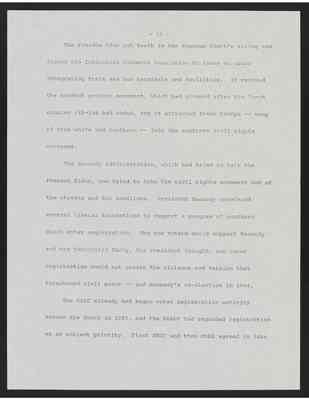Pages
16
for New Orleans on a special plane. The CORE Freedom Ride had come to an end.
But veterans of the previous year's sit-in struggles would not let the Freedom Ride die. Sit-in student leaders from Nashville took up the Ride, and when they finally reached Montgomery, police allowed a mob of over 1,000 whites to beat the Riders without interference.
The violence, and the apparent complicity of Alabama officials, was headline news around the world. Once again America's unfulfilled promise of equality was exposed, and for the first time, the federal government decided to act.
Having failed to stop the Riders, President Kennedy decided to protect them, arranging their safe passage from Montgomery to Jackson, Mississippi. Attorney General Robert Kennedy agreed that Mississippi officials could continue to segregate their bus facilities if they would guarantee protection for the Riders. By the end of the summer, 328 Freedom Riders had been jailed in Mississippi.
17
The Freedom Ride put teeth in the Supreme Court's ruling and forced the Interstate Commerce Commission to issue an order integrating train and bus terminals and facilities. It revived the student protest movement, which had slumped after the lunch counter sit-ins had ended, and it attracted fresh troops -- many of them white and northern -- into the southern civil rights movement.
The Kennedy Administration, which had tried to halt the Freedom Rides, now tried to take the civil rights movement our of the streets and the headlines. President Kennedy convinced several liberal foundations to support a program of southern Black voter registration. The new voters would support Kennedy and the Democratic Party, the President thought, and voter registration would not create the violence and tension that threatened civil peace -- and Kennedy's re-election in 1964.
The SCLC already had begun voter registration activity across the South in 1957, and the NAACP had regarded registration as an ancient priority. First SNCC and then CORE agreed in late
18
1961 that voter registration would become an important part of their future activity.
SNCC took its registration drive to the state most feared by civil rights movement workers, to the southwest corner of Mississippi.
Rev. George Lee and Lamar Smith had been murdered in Mississippi in 1955 for voter registration activity. Fourteen-year-old Emmet Till had been kidnapped and slain in Mississippi in 1955 for talking to a white woman. Charles Mack Parker, accused of raping a white woman, had been taken from a jail and killed in 1959. No one had ever been punished for these crimes, or for other killings of Mississippi Blacks.
SNCC's first registration school was located in McComb. After a series of arrests and beatings of SNCC workers, a local Black farmer, Herbert Lee, was shot and killed. Three years later, Lewis Allen, who had witnessed the Lee killing, was murdered by a shot-gun blast in his front yard. No one was ever arrested for either killing.
19
The voter registration campaign soon spread throughout Mississippi, but with few results. Violence, terror, and economic intimidation kept many Blacks from applying to register. Registration offices were open irregularly. Many of those who did apply often failed the difficult registration test.
On October 1, 1962, white students and townspeople at the University of Mississippi in Oxford rioted to prevent James Meredith from becoming the University's first Black student. A French reporter, Paul Guithard, was killed during the riot.
In the fall of 1961, the southwest Georgia town of Albany became the center of extended demonstrations -- begun by SNCC but soon joined by SCLC and Dr. King -- that ended a year later with little change for the region's Blacks. King's entry into the Albany movement attracted national attention but no federal response, and a voter registration campaign run by SNCC in the rural counties surrounding Albany met violent resistance -- burnings, beatings, and arrests -- and registered few voters.
King and SCLC selected Birmingham, Alabama -- called
20
"Bombingham" by Blacks because of its history of racist violence -- as the site for their next campaign. Birmingham was the South's most segregated city. Few Blacks were voters, few had jobs with the city, and the police department was noted for the brutality with which it dealt with Blacks.
Careful planning preceded King's Birmingham campaign, and the expected brutal reactions of Birmingham's police force helped attract national concern. King was arrested several times, and while in jail he wrote his famous "Letters from a Birmingham Jail," condemning white moderates for their failure to support Black aspirations.
During the Birmingham protests, a white postman from Baltimore, Maryland, was shot and killed in nearby Gadsden, Alabama, while on a one-man march supporting integration.
On May 3, King decided to use school children as demonstrators. Within a few days, thousands of children, some as young as six years old, had faced snarling police dogs and powerful fire hoses wielded by police to joyfully enter




